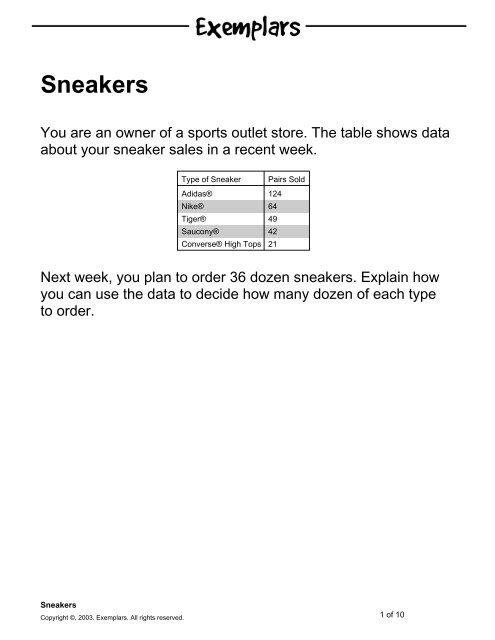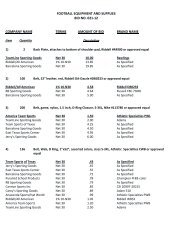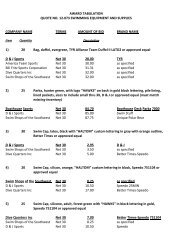Create successful ePaper yourself
Turn your PDF publications into a flip-book with our unique Google optimized e-Paper software.
<strong>Sneakers</strong><br />
You are an owner of a sports outlet store. The table shows data<br />
about your sneaker sales in a recent week.<br />
Type of Sneaker Pairs Sold<br />
Next week, you plan to order 36 dozen sneakers. Explain how<br />
you can use the data to decide how many dozen of each type<br />
to order.<br />
<strong>Sneakers</strong><br />
Copyright ©, 2003. Exemplars. All rights reserved.<br />
Adidas® 124<br />
Nike® 64<br />
Tiger® 49<br />
Saucony® 42<br />
Converse® High Tops 21<br />
1 of 10
Grade Levels 6 - 8<br />
<strong>Sneakers</strong><br />
You are an owner of a sports outlet store. The table shows data about your sneaker sales in a<br />
recent week.<br />
Type of Sneaker Pairs Sold<br />
Next week, you plan to order 36 dozen sneakers. Explain how you can use the data to decide<br />
how many dozen of each type to order.<br />
Context<br />
This sixth grade class did some informal and more formal work with percents. It was their first<br />
formal academic exposure to percents. We also had worked with fractions, with a very limited<br />
introduction to ratios. I realize how important the concept of proportionality is and want to<br />
expose my students to many types of problems that deal with data.<br />
What This Task Accomplishes<br />
I wanted this task to assess which students recognized the fact that percents or ratios could<br />
help in solving this problem. I would also be able to see which students did not have a working<br />
knowledge of proportionality. The data is messy (the number of pairs of sneakers sold last year<br />
does not divide to dozens of sneakers evenly). Students have to make decisions about<br />
estimating the distribution of pairs of sneakers.<br />
What the Student Will Do<br />
Most students started by changing 36 dozen sneakers to 432 pairs of sneakers. Other students<br />
renamed the pairs of sneaker sold last week to dozens. From that point on the strategies<br />
varied. Some students recognized that percents could help solve the problem, others used a<br />
formal concept of proportions, and others had a more intuitive feeling for proportions. Still<br />
others ignored the data and distributed the 36 dozen sneakers evenly.<br />
Time Required for Task<br />
50 minutes<br />
<strong>Sneakers</strong><br />
Copyright ©, 2003. Exemplars. All rights reserved.<br />
Adidas® 124<br />
Nike® 64<br />
Tiger® 49<br />
Saucony® 42<br />
Converse® High Tops 21<br />
2 of 10
Some students needed more time to write up their reasoning and organize their response.<br />
Interdisciplinary Links<br />
Students can get a sense of what stores must think about as they try to meet their customers'<br />
needs and make a reasonable profit.<br />
Teaching Tips<br />
Have calculators available for the computation. It is always interesting to see how students<br />
interpret decimal remainders when using calculators.<br />
Suggested Materials<br />
Calculators<br />
Possible Solutions<br />
Answers may vary according to the reasoning and estimating used by each student. Solutions<br />
should be close to the findings below:<br />
Adidas® sold 124 out of 300 or about 41% of the sneakers last week. You may want to order<br />
41% of the 36 dozen (or 432 pairs) which is about 14.8 or 15 dozen.<br />
Nike® sold 64 out of 300 or about 21% of the sneakers last week. You may want to order 21%<br />
of the 36 dozen which is about eight dozen.<br />
Tiger® sold 49 out of 300 or about 16% of the sneakers last week. You may want to order 16%<br />
of the 36 dozen which is about six dozen.<br />
Saucony® sold 42 out of 300 or about 14% of the sneakers last week. You may want to order<br />
14% of the 36 dozen which is about five dozen.<br />
(This leaves only two dozen for Converse® High Tops.)<br />
Converse® High Tops sold 21 out of 300 or about 7% of the sneakers last week.<br />
You may want to order 7% of the 36 dozen which is about 2.52 or two dozen.<br />
Benchmark Descriptors<br />
Novice<br />
The solution has no relationship to the task. It looks like the student divided Adidas® pairs of<br />
sneakers in half, but even that strategy is not consistent with the rest of the brands. There is<br />
<strong>Sneakers</strong><br />
Copyright ©, 2003. Exemplars. All rights reserved.<br />
3 of 10
only a limited explanation, but enough to show the student did not understand how to approach<br />
the problem.<br />
Apprentice<br />
Although this student has a reasonable solution, there is no evidence of how those numbers<br />
came about. What was the child's strategy or reasoning? If they added "a little more to each"<br />
then why were about five dozen added to Adidas® and only four pairs of sneakers added to<br />
Converse®? There are too many questions about this child's strategy and reasoning. I would<br />
want a conference with this student to see if they could better explain their solution.<br />
Practitioner<br />
Although this student is not very confident about his/her approach (his/her last line said s/he<br />
thought that most of her work was just guessing), for the most part, it is a mathematically sound<br />
strategy. S/he is trying to keep the sneaker sales proportional. S/he adds to the chart that is<br />
already there for the representation and has a clear explanation.<br />
Expert<br />
The solution shows a deep understanding of the problem. The student connected the idea of<br />
percents to keep the proportionality of the sneakers sold. This strategy leads directly to a<br />
solution. S/he also verified his/her results and realized that strictly rounding would cause his/her<br />
total to be too big and made a decision to lower one estimate. There is a clear and effective<br />
explanation detailing how the problem is solved. There is precise and appropriate mathematical<br />
terminology and notation.<br />
<strong>Sneakers</strong><br />
Copyright ©, 2003. Exemplars. All rights reserved.<br />
4 of 10
Novice<br />
<strong>Sneakers</strong><br />
Copyright ©, 2003. Exemplars. All rights reserved.<br />
5 of 10
Apprentice<br />
<strong>Sneakers</strong><br />
Copyright ©, 2003. Exemplars. All rights reserved.<br />
6 of 10
Practitioner<br />
<strong>Sneakers</strong><br />
Copyright ©, 2003. Exemplars. All rights reserved.<br />
7 of 10
Expert<br />
<strong>Sneakers</strong><br />
Copyright ©, 2003. Exemplars. All rights reserved.<br />
8 of 10
Expert<br />
<strong>Sneakers</strong><br />
Copyright ©, 2003. Exemplars. All rights reserved.<br />
9 of 10
Expert<br />
<strong>Sneakers</strong><br />
Copyright ©, 2003. Exemplars. All rights reserved.<br />
10 of 10








